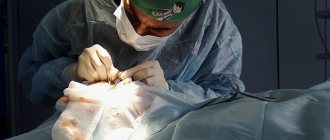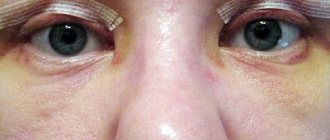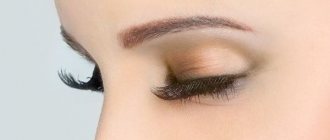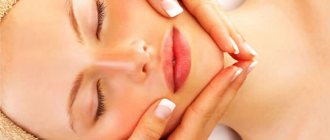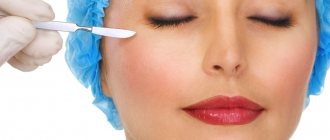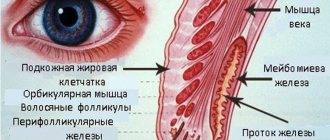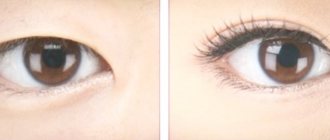The first signs of aging appear in the periorbital zone. The area around the eyes is most vulnerable to age-related changes, which is why blepharoplasty is one of the most popular areas of anti-aging medicine. Eyelid surgery eliminates the following problems:
- Drooping and fatty deposits on the upper eyelids;
- Swelling of the lower eyelids due to bulging fatty tissue, giving the entire face a tired appearance;
- Dark circles under the eyes;
- Wrinkles are superficial and deep.
Surgical blepharoplasty, for all its advantages, has a number of serious disadvantages:
- There is a whole list of contraindications (blood diseases, heart diseases, rheumatism, bronchial asthma);
- The operation requires general anesthesia;
- The need for sutures;
- A long period of rehabilitation, accompanied by severe swelling, pain and hematomas (bruises);
- The result is noticeable only after a month;
- Complications are likely (blepharoptosis - drooping of the upper eyelid, eye asymmetry, tearing, etc.).
The phrase “beauty requires sacrifice” does not stand the test of time. Modern technologies offer qualitatively new ways to get rid of skin defects around the eyes, the effectiveness of which is comparable to surgical intervention. At the same time, alternative blepharoplasty is less dangerous than a surgical scalpel.
Objectives
Non-surgical blepharoplasty is aimed at restoring the physiological elasticity of the eyelids and improving their appearance. The procedure will achieve the following effects:
- fill and smooth out wrinkles under the eyes;
- eliminate excess skin, for example, with an overhanging eyelid;
- adjust the shape of the eye;
- improve the condition of local tissues - connective tissue and muscles;
- fill bags under the eyes, remove excess fat deposits and hernias;
- restore normal skin metabolism, increase its nutrition and hydration;
- correct eyelid asymmetry.
Eyelid surgery significantly refreshes the face and improves its appearance. The procedure allows you to actively fight the aging process. The age at which blepharoplasty is necessary depends on the individual characteristics of the skin. When the first age-related changes appear, it is worth
What is the essence of the corrective procedure ↑
Lipofilling is a method of correcting defects based on transplanting the patient’s fat cells into the problem area. The doctor is armed only with a syringe; the skin is not damaged by a scalpel and is not exposed to the laser. The only manipulation is injections. When does the magic technique help?
Lipofilling will change your appearance for the better if you have the following problems:
- disproportion of eyelids;
- fine wrinkles around the eyes;
- retraction of the upper eyelid;
- excessive hernia removal;
- circles and bruises under the eyes;
- contour violations;
- consequences of unsuccessful plastic surgeries;
- looking too haggard;
- birth defects.
During lipofilling, your own adipose tissue is “relocated” to the problem area
Types of blepharoplasty
The plastic method includes a wide range of types, among which injection and hardware methods can be distinguished. Each type of non-surgical blepharoplasty has its pros and cons.
Injection therapy
Injection blepharoplasty involves the injection of medications into the eyelid area. The products increase the elasticity of the skin, restore the healthy appearance of the skin and actively eliminate local age-related changes. Most often, preparations are made based on hyaluronic acid, which is a natural component of the skin.
Non-surgical upper eyelid blepharoplasty is divided into two types depending on the goals of the procedure:
- Blepharoplasty of the first type involves straightening the contour of the eyelids and “filling in” wrinkles using lifting techniques. These include procedures such as biorevolutometry, biorevitalization, and hyaluronic therapy. The most promising drugs of this type are HAfiller, Teosyal, Stylage.
- The second type of blepharoplasty is aimed at eliminating swelling and fatty formations in the eyes and eyelids. For this purpose, lipolytic drugs are used to resolve pathological objects and restore the elasticity of the skin under the eyes. In addition, preparations of this type contain a large amount of enzymes and vitamins necessary for tissues.
The choice of treatment method is determined by a cosmetologist based on an assessment of the quality of the skin under the eyes. Based on the examination, the surgeon will determine the necessary direction of work with the patient and select the optimal preparations for cosmetic blepharoplasty.
In addition to the classic injection procedure, the plasma eyelid surgery method is now being actively introduced. It involves the introduction of cold human plasma, previously selected from a vein and processed in a special way. Plasma has a pronounced restorative effect, due to which the lower and upper edges of the eye are smoothed out in patients, thereby ensuring normal skin elasticity.
Due to the fact that plasma is of natural origin, complications are practically impossible during the procedure. The effectiveness and safety of the technique allows it to be widely used to eliminate age-related changes on the eyelids.
Laser blepharoplasty
Laser treatment of the eyelids is one of the most effective methods of lifting this area. Thanks to the ability to fine-tune the laser beam, it is possible to achieve a targeted effect on those layers of skin that need to be removed. A competent choice of intensity of influence ensures complete safety of the procedure for healthy tissues.
Non-surgical plastic surgery involves removing fatty deposits from the eyelids using a carbon dioxide laser, which penetrates deep into the skin and removes excess tissue from the area. During the procedure, you can also remove excess skin, for example, from the surface of the overhanging eyelid. This intervention allows you to restore the normal appearance of the skin without plastic surgery.
Laser therapy has many advantages compared to classical surgery. During surgical plastic surgery, noticeable stitches remain, which then have to be hidden with sunglasses. If laser treatment is carried out, then there are practically no scars left at the site of the intervention, and they are quickly covered with healthy epithelium. In the photo before and after blepharoplasty surgery, positive changes are immediately visible.
In addition, during the procedure, the laser beam actively seals the lumens of damaged small vessels of the eyelid. Thanks to this, there is no heavy bleeding, both during the intervention and in the postoperative period. Cauterization of tissues also ensures disinfection of surfaces, which prevents bacteria from entering the wound. This significantly reduces the likelihood of complications of the disease. These benefits indicate whether laser or surgical blepharoplasty is better.
Laser treatment is used to correct both the upper and lower eyelids. An additional service may be changing the shape of the eyes, which is widely used in patients with an Asian type of appearance.
In addition to the lifting effect, non-surgical laser blepharoplasty of the upper eyelids provides skin resurfacing. Thanks to this, the top layer of cells is restored, which has an additional rejuvenating and refreshing effect.
Threadplasty
Thread blepharoplasty involves the introduction of special gold threads into the skin, which provide tissue tightening. They penetrate into the upper layers of the dermis, where gold exerts its biological effect:
- Restores normal microcirculation in tissues;
- Improves skin nutrition;
- Provides oxygen flow to tissues;
- Stimulates local metabolism.
Restoring the elasticity of the tissues under the eyes, combined with the beneficial effects of gold, provides a quick treatment result. However, it is important to understand that this technique is more likely to have a preventive purpose. Gold threads can correct only minor age-related changes; in the presence of pronounced wrinkles and other symptoms of aging, they will not be as effective as other blepharoplasty methods.
Hardware blepharoplasty
Hardware blepharoplasty involves the use of specialized equipment that has a tightening effect on the patient’s skin. Stimulation of the dermis provides not only noticeable tissue tightening, but also a rapid improvement in their condition due to increased production of collagen and elastin.
The group of hardware methods of blepharoplasty includes the following methods of influence:
- Thermage is a restorative treatment using high-frequency radio waves. This procedure is performed under local anesthesia. The device sends precise waves into the thickness of the skin, which ensures its active heating. The procedure helps to accelerate local metabolism, and against the background of exposure, restoration and renewal processes are actively launched in the tissues.
- Ultrasonic smas-lifting is the effect of ultrasonic waves on the deep layers of the skin, which ensures the restoration of the elasticity of collagen fibers. These structures provide skin elasticity, so their “twisting” under the influence of ultrasound provides a good lifting effect.
- Non-surgical plasma current blepharoplasty involves applying electrical charges to the eyelid area. At the same time, active heating occurs in the tissues, which accelerates metabolism and improves skin condition. Point exposure to low-power currents does not lead to severe trauma to the skin, and the patient has virtually no discomfort during the procedure.
With the help of electroplasty, it is possible to eliminate changes such as the subcutaneous fat layer, bags under the eyes, and small wrinkles. In addition, electroblepharoplasty is often used for Europeanization in patients with Asian appearance.
Hardware treatment methods can quickly improve the condition of patients' eyelids. At the same time, they are low-toxic and safe. This allows us to consider them an excellent alternative to surgical correction, as evidenced by the positive reviews of non-surgical eyelid blepharoplasty.
Endoscopic blepharoplasty
One of the newest methods of eyelid surgery is endoscopic blepharoplasty - a minimally invasive procedure that allows you to most accurately correct age-related changes in the skin. The procedure involves making small incisions in the area of the intervention through which special instruments will be inserted.
During the intervention, a specialist can assess the condition of the skin from the inside and correct possible deficiencies. Due to the small incision used, there are no scars left on the face after surgery. The ability to accurately assess ensures optimal face lifting without further complications.
The effectiveness of blepharoplasty with injections
The range of problems solved using the injection procedure is very wide. Several sessions are a worthy replacement for surgical blepharoplasty. The components of the injections do not contain dangerous chemicals, but have a calming and renewing effect.
The effectiveness of injections is undeniable:
- the skin on the eyelids is restored naturally: dryness disappears, wrinkles are smoothed out;
- subcutaneous fat disappears in the problem area;
- the epidermis under the eyes brightens;
- ptosis on the outer corners and upper eyelid is eliminated;
- the hernia under the eyes disappears.
The duration of preservation of the result is influenced by age, the tendency of the skin to wither, and the patient’s lifestyle. Usually a repeat course is needed no earlier than after 2 years.
Indications for blepharoplasty
The main indications for non-surgical blepharoplasty are age-related changes in eyelid tissue:
- pronounced bags under the eyes;
- impending century;
- dry skin around the eyes, wrinkles;
- the presence of fatty formations and hernias;
- ptosis – drooping eyelid;
- asymmetrical position of the eyelids.
Thus, the procedure is performed for aesthetic reasons. If the patient wants to improve his appearance and restore the elasticity of the skin in the area under the eyes, then he is recommended to use one of the non-surgical blepharoplasty techniques.
What is the alternative to surgical blepharoplasty?
You can improve the appearance of your face and make your eyes more expressive without going through a difficult rehabilitation period after surgery. Alternative methods include:
- Eyelid contouring by injection - injection of active components through a needle.
- Hardware correction:
- thermolifting – activation of cell division and renewal of the dermis by infrared radiation;
laser correction – stimulating the production of elastin and collagen with a heating beam;
- ultrasonic SMAS lifting – compression of stretched fibers through pulses of different lengths;
- Thermage is the synthesis of collagen under the influence of radio waves.
- Lifting with mesothreads is the introduction under the skin of thin self-absorbable or non-absorbable threads, the components of which activate collagen production, smooth out wrinkles, and slow down aging. This is an excellent alternative to surgical blepharoplasty of the upper eyelids , because it provides the same result with minimal tissue trauma and lasts up to 7 years.
All procedures have results comparable to plastic surgery, but are performed under local anesthesia or without any anesthesia at all, and are characterized by minimal trauma and quick recovery.
What are the contraindications?
Despite the complete safety of the procedure, it is not recommended if the patient’s body is significantly weakened and there are acute pathological processes. Contraindications to eyelid surgery are:
- diabetes mellitus in the decompensation phase;
- acute infectious processes or exacerbation of chronic inflammation in the body;
- presence of bleeding disorders;
- acute diseases of the heart and respiratory system;
- the presence of malignant neoplasms.
It is not recommended to perform the procedure during periods of pregnancy and lactation. This is due to the fact that any external influence on the body during this period is undesirable, since it represents additional stress for the mother and, as a result, for the child.
Traditional methods
There are also time-tested folk methods with which you can slightly tighten the upper eyelid at home. Their advantage is that they are cheap and lack any chemicals. The downside is the fragility of the result.
Rather, these are still preventive measures that do not allow intensive lifting:
- Massage. It is advisable to do lymphatic drainage massage of the face and especially the area around the eyes regularly, even for those who do not yet have age-related problems. It promotes skin detoxification, improves blood circulation and slows down destructive processes. It's easy to learn from a video. It is better to perform it in the morning or at least 2 hours before bedtime, removing all decorative cosmetics. The course of treatment is 10-15 sessions every other day, and then constantly 1-2 times a week.
- Gymnastics. It should become a useful habit, which also improves vision and helps fight crow's feet. Complexes are easy to find on the Internet or women's magazines. It is advisable that they include comments from specialists, since if the exercises are performed incorrectly, it can provoke the formation of new wrinkles.
- Masks . They do not solve the problem radically, but they help nourish the delicate skin of the eyelids with useful substances. Good results are obtained from patches soaked in hyaluronic acid or peptide complexes. Followers of all-natural remedies can apply tea bags or freshly cut potato rounds to their eyes.
Naturally, after any procedure you need to apply cream to your eyelids. It is chosen taking into account the age and condition of the skin. Among the brands that are close to natural, the first places in consumer ratings are occupied by the brands “Biocon”, “Granny Agafya’s Recipes” and “Black Pearl”.
It is better to buy high-tech products from European companies, Uriage, Lancome and others.
How is blepharoplasty performed?
Non-surgical plastic surgery is carried out on an outpatient basis; it does not require going to the clinic for a long time. During the procedure, there are several stages, each of which affects how blepharoplasty will go.
Preparation
Before undergoing eyelid surgery, the patient must make an appointment with a dermatologist, who will evaluate the condition of her eyelids. The specialist determines the tone of cartilage tissue, the depth of facial wrinkles, the presence of excess skin, and its volume.
After the examination, the doctor prescribes additional examination methods. This includes blood tests, ECG, coagulogram. Research is necessary in order to assess the condition of a woman’s body and decide whether she can undergo plastic surgery. The last stage of preparation is computer modeling of a possible result based on the patient’s preferences and doctor’s recommendations.
Indications and contraindications for injection eyelid surgery
The procedure is recommended to prevent skin aging, as well as for pronounced external flaws around the eyes:
- lower eyelid hernia;
- swelling;
- drooping upper eyelids;
- dark area under the eyes;
- omission of outer corners;
- wrinkled mesh;
- thinning and dry skin;
- pronounced nasolacrimal groove.
With the help of non-surgical injection blepharoplasty, the surgeon can widen the eye shape and correct the Asian type of eyelid shape.
Not everyone can undergo the procedure, so the doctor will prescribe an additional examination to exclude contraindications:
- intolerance to injection components;
- infection;
- severe stage of chronic pathology;
- pregnancy, lactation;
- vision problems (not always);
- predisposition to conjunctivitis.
On an individual basis, the doctor can identify other reasons that impede the normal course of the procedure. The patient will need to undergo treatment, and in some cases, completely abandon injection blepharoplasty of the lower eyelids, upper eyelids, or a complex procedure.
Stages of the procedure
Non-surgical eyelid surgery consists of the following stages:
- Disinfection of the eyelid area.
- Putting special lenses on the eyes to protect them from external influences.
- Carrying out hardware effects or injection procedures.
- Postoperative disinfection of the intervention area.
- Applying a cold compress to relieve swelling.
Sometimes blepharoplasty requires additional marking of the eyelid area, which is done before the actual administration of the drug. This stage ensures more accurate lifting.
Non-surgical methods ↑
Non-surgical eyelid lifting methods include: lifting eyelid cream, gymnastics, makeup. All this can be successfully done at home.
You can prolong the youth and attractiveness of your eyelids without surgical intervention in any conditions, including at home, if you systematically perform physical activity that strengthens the muscles and slows down the aging of the skin of the eyelids. There are many types of facial and eyelid exercises that can help your face look healthy, beautiful and combat the signs of aging.
Proper use of decorative cosmetics will also help hide age-related changes on the eyelids. Lifting makeup can rejuvenate and refresh the face, visually lift the eyelids.
Here are some makeup tips:
- Do not use too bright or aggressive colors in makeup and excessively use pearlescent shadows;
- use matte, neutral tones;
- Direct the line of the outer edges of the eye guides upward;
- dark circles under the eyes can be masked with foundation or powder.
To maintain the skin of the eyelids in tone and give it a fresh look, it is worth doing a massage with ice cubes every day at home (it will be more beneficial if you do it with a decoction of mint, nettle, and chamomile). There are many useful masks that can be easily prepared and applied at home.
Various oils have a beneficial effect on the skin of the eyelids, for example, grape seed oil, almond oil, sesame oil, peach oil. Oils can also be applied before facial exercises.
Rehabilitation after blepharoplasty
The success of the procedure largely depends on how correctly the patient takes care of his eyelids during the rehabilitation period of blepharoplasty. To do this, it is recommended to follow the following recommendations:
- To get rid of bruises after blepharoplasty, during the rehabilitation period it is necessary to treat the tissue daily with soothing and restorative agents.
- Make-up should not be applied to the eyes, as cosmetics may contain components that irritate the eyelids.
- The woman should avoid direct sunlight on the intervention area - she is recommended to wear sunglasses at all times.
During recovery after blepharoplasty, it is prohibited to go to solariums, baths and saunas after the intervention.
How to tighten eyelids at home
Wrinkles and sagging in the eyelid area are often attributed to thin skin. Such skin really stretches, especially due to swelling, mechanical pressure and friction, and daily incorrect care when applying cream. In addition, with age, the shape of the orbicularis oculi muscle and neighboring muscles changes under the skin. They weaken and put pressure on the eyelids. All together visually makes the eyes smaller and they look sunken. Therefore, we add an exercise to lift the temples and corners of the eyes.
The temporalis muscle affects the position of the corner of the eye and puts pressure on the side of the eye. Decreasing in size, it pulls the corner of the eye and eyebrow down, covers the eye, reduces peripheral vision, and gives a sad expression to the face. Look at the anatomical picture. The temporoparietal muscle is located on the lateral surface of the skull.
How to do. Place your palms to your temples, as in the photo. The base of the palms is in the temporal fossa (the fossa is formed when the mouth opens). Pull your arms slightly towards the top of your head.
Close your eyes slowly and tightly. 10–15 times in dynamics (blinking).
Stay static for 10 seconds (with your eyes closed).
As you perform the exercise, you will feel the muscles moving under your palms.
Result. Take your hands away and compare the sensations. Look in the mirror. Do you see? Often, after the first execution of the exercise, the corner of the eye and the tip of the eyebrow rise, as you do now.
Advertising
In the photo below you can see that the upper eyelid is heavy and lies in a fold on the eyelashes, covering the corner of the eye. I looked like this almost eight years ago, at 32. I was young, energetic, and everyone around me said that I was inventing problems for myself.
During my immersion in the topic of natural facial restoration, I realized that there are people who show age-related changes earlier than their peers. Now I know for sure that if I had not done face fitness, then by the age of 40 my eyes would have been even heavier and my eyes would have looked even smaller.
Average prices for blepharoplasty
The cost of non-surgical blepharoplasty procedures is determined by the type of procedure performed. Average prices for treatment are:
- injection therapy – 10-15 thousand rubles;
- hardware impact – 50-60 thousand rubles;
- electroplastics – 15-20 thousand rubles;
- laser treatment – from 50-60 thousand rubles.
The cost of blepharoplasty depends not only on the clinic’s policy, but also on the severity of the intervention in a particular patient. When choosing a treatment method, you need to pay attention to the reviews and consequences of laser blepharoplasty in each clinic.
Lymphatic drainage massage
The massage is aimed at improving the outflow of fluid through the lymphatic vessels. This helps maintain skin elasticity.
The procedure is recommended for:
reducing swelling;- destruction of facial wrinkles;
- improvement of blood vessels, cells;
- relieving excess tension from the eyes.
Contraindications:
- eye surgery performed earlier than 6 months ago;
- the presence of inflammatory processes;
- serious diseases (heart, liver, skin, endocrine system, etc.).
Pros of the procedure:
- reducing the amount of fluid and fat;
- even out skin color;
- further reduction of swelling;
- relatively low cost.
The disadvantages include the short effect of the procedure (you will have to repeat it regularly). Compared to blepharoplasty, massage must be repeated regularly, but it affects the color of the skin around the eyes and relieves tension (we talk about how long the effect of blepharoplasty will last here).
| In Moscow | In St. Petersburg | |
| Average price (in rubles) | 1.500-6.000 | 1.300-3.800 |
Customer reviews of non-surgical eyelid blepharoplasty
Alexandra, 43 years old, Taganrog:
For me, injection blepharoplasty has become a real godsend, since I am very afraid to do a regular operation. The procedure helped me get rid of wrinkles under my eyes. Of course, the result does not last long, but it is worth it to sign up for a repeat procedure.
Elena, 47 years old, Moscow:
I underwent laser blepharoplasty and am very pleased with the results. Now I have no bags under my eyes, no wrinkles or folds. I look almost ten years younger.
Hardware procedures
Hardware techniques do not provide such a quick and significant effect as surgery. But they rejuvenate the eyelids not only visually. Intense exposure stimulates natural skin regeneration processes. However, the procedures have age restrictions and do not help after 50-55 years.
Cosmetologists consider the following to be the optimal options for non-surgical eyelid lifting:
- Radio wave lifting. The procedure is quite expensive and not very pleasant for the patient. But it stimulates the production of collagen and elastin, restoring lost skin turgor.
- Microcurrents. This type of therapy helps to work not only the skin, but also the small facial muscles that form a natural frame for it. It gives results at any age, but it will not restore severely sagging eyelids.
- Photorejuvenation. More suitable for patients under 45 years of age whose natural collagen synthesis has not yet slowed down too much. Additionally, it stimulates and has an anti-inflammatory effect.
To get a good result, you need to complete a course of 5-6 procedures with an interval of 1-2 weeks, and then you can maintain it by doing a couple of sessions every six months.
Cost of the procedure
RF eyelid lift using a Thermafine device costs 6,500 rubles.
If treatment of the entire face is required, the price will be 10,000 rubles. From time to time we have discounts on radio wave lifting, stay tuned for updates on the website and publications on Instagram. All Medial cosmetologists perform RF lifting, so you can make an appointment with us on any convenient day. We work every day, without holidays and weekends, and are always happy to meet you! Cosmetology at the multidisciplinary clinic “Medial” means attention to each patient and a guarantee of the effectiveness of all procedures.
Sign up for Thermafine therapy by phone: +7 (499) 137-00-00
Laser blepharoplasty
Laser blepharoplasty is especially popular among women, since positive dynamics in making the skin look younger becomes possible after 5 sessions.
The effectiveness of the procedure is ensured by a laser that breaks down fat deposits passing through a special scanner. At the point of contact, the area of skin begins to peel off and becomes covered with crusts, which are rejected after a five-day period.
Laser blepharoplasty has the following positive aspects:
- Eliminates swelling and swelling in the eye sockets, maintaining the effect for 3 years.
- The first result is visible after 24 hours. Subsequently, each session improves the appearance of the skin surface.
A significant disadvantage of this cosmetic operation is the high cost (RUB 7,500).
Still have questions? Contact us:
Contraindications to blepharoplasty and new alternative methods of eyelid correction
When talking about blepharoplasty, Professor Bely constantly repeats the words “in many cases”
and about
“almost always”
. We became interested in these “almosts” and found out that
- Blepharoplasty is not the only method for correcting the eye area,
- There are patients (and they are not so rare) for whom blepharoplasty does not help,
- in some cases, blepharoplasty is directly contraindicated, since as a result, instead of bags under the eyes, you can get dips or deformation of the shape - the so-called fish eye.
After listening to the “horror stories,” you will inevitably want to know how to find out in advance whether blepharoplasty will give the desired effect and what to do if blepharoplasty is not indicated.
What alternatives to blepharoplasty can a plastic surgeon offer?
Let's look at why blepharoplasty may not be effective. It would seem that nothing could be simpler - remove excess skin, remove fat bags, and everything should work out! What's the trick here? First of all, you need to understand the cause of the problems.
Where does excess skin on the eyelids come from? Sometimes the reason is simply aging and stretching of the thin, delicate skin of the eyelids. Then everything is simple - we use blepharoplasty and remove excess tissue. But quite often, excess skin occurs not only due to aging of the eyelid tissue, but also due to changes (ptosis) in neighboring areas of the face. If the eyebrows move downward, the upper eyelids begin to droop as a result.
And if the painting zones “slide down”, not only nasolabial folds are formed, but also dips, wrinkles and bags under the eyes.
It is clear that in such cases, blepharoplasty, which only involves correction of the eyelids themselves, cannot effectively solve the problem of returning tissue to its natural place. After all, to lift adjacent tissues, working with the eyelids is obviously not enough. In order to also raise the eyebrows or at the same time “tighten” the middle zone of the face (from the lower eyelids up to the nasolabial folds), you need to use other techniques that will provide a complex effect.
Plastic surgeon prof. I.A. White.
The question remains: will the use of such techniques with a large volume of correction lead to complications and prolongation of the rehabilitation period?!
The good news is that modern surgical techniques for simultaneous eyelid correction and eyebrow lifting, as well as for lifting the midface and lower eyelids, do not require additional incisions. A comprehensive eyelid and eyebrow lift with simultaneous lifting of the midface area (checklifting) is carried out without unnecessary stitches. All stages of correction of these zones are carried out through the same incisions that are made during conventional blepharoplasty: an incision on the upper eyelid is used to lift the forehead, eyebrows and upper eyelid, and on the lower eyelid to correct the lower eyelids and lift the entire middle zone (including nasolabial folds). Thanks to small incisions and a gentle tightening technique, the operation does not become more difficult for the patient. The rehabilitation period in such cases also does not lengthen or become more difficult.
Injection blepharoplasty
Injection blepharoplasty involves performing injections under the epithelial tissue of the eye. The effectiveness of the procedure is explained by the introduction of drugs of natural origin (Hyaluronic acid, amino acids, vitamins, phytoestrogens).
A positive effect is observed in unadvanced cases of hernia on the eyelid, and wrinkles of any depth.
The negative aspects of manipulation include:
- the possibility of developing allergic reactions;
- pain during the procedure;
- long-term development of the visual effect (approximately 2 weeks);
- unsuccessful injection can cause spastic contraction of the eyelids or cause drooping of the brow arches.
The price ranges from 2000 to 4000 rubles.
Asian eyelid blepharoplasty
Residents of Asian and Eastern countries have their own eye shape. They lack a supraorbital fold, and the presence of epicanthus (overhanging skin) at the inner corner of the orbit creates the appearance of edema.
Blepharoplasty of Asian eyelids is performed mainly on young people who strive to have a European appearance. This procedure has another name : Singapore
.
There are 2 ways to perform blepharoplasty on Asian eyelids:
1.
With making the cut. The fold is formed after removing excess skin and fatty tissue.
2.
Without cutting soft tissues. A plastic surgeon creates invisible sutures from the inner surface of the eyelids. This leads to the formation of a supraorbital fold.
The second method is less traumatic, but it has a good effect only with a slight incision of the visual organs.
Rf lifting around the eyes - procedure technology
To carry out radio wave rejuvenation, we use the Thermafine device. There is no need to use anesthesia - the session is comfortable and quick. The doctor cleans the area around the eyes and applies a special gel conductor to it. The procedure takes no more than 20 minutes. While treating the area around your eyes, you will feel the tissue warming up. The temperature on the device is set individually for each patient. At the end of the session, the doctor will apply a moisturizing cream to the skin of your eyelids.
Skin care after RF eye lifting
Since radio wave lifting does not damage the skin, there is no need to use healing ointments. In the first days after the procedure, it is not recommended to use cosmetics in the area of the upper and lower eyelids. For three to five days, solariums and saunas are prohibited. You can't stay in the open sun. You should not visit the pool.
After a couple of days you will return to your normal rhythm of life. After the first session you will see positive changes on your skin. After a month, they will become more noticeable - RF lifting has an increasing effect. After a course of procedures, you can achieve results comparable to laser or surgical rejuvenation.
Contraindications
Despite the fact that such eyelid correction involves virtually no intrusion into the body, there are still situations where restrictions are imposed on non-surgical eyelid blepharoplasty. Reviews of people who have undergone these procedures and consultations with specialists will tell a potential client of a cosmetologist in detail about general contraindications. Briefly they are as follows:
- inflammation of the skin or eyes;
- pregnancy;
- heart sensors;
- lactation;
- chronic and acute infectious diseases;
- oncology;
- diseases of the endocrine system;
- flu, cold.
Transconjunctival blepharoplasty
If we compare transconjunctival blepharoplasty with a classic eyelid lift, we can note that this procedure is gentle and has a short recovery period of 7 to 10 days.
The procedure is performed using an endoscope followed by modeling the shape of the eyebrows. To improve the effect, implantation is allowed.
During the operation, the following sequence is observed:
- The surgical area is injected with a local anesthetic. To minimize the possibility of bleeding, the administration of the anesthetic is combined with Adrenaline.
- In the area of the problematic area (from the inside), a puncture is made to guide the instrument. No additional incisions are made.
- After removing the fat bags, the puncture site is tightened with suture material, which dissolves within seven days. In some situations there is no such need.
During the recovery period, the patient needs to wear a sterile bandage for the first 2 days. To eliminate swelling, it is recommended to use cool compresses, and after removing the bandage, hypoallergenic gels are prescribed, and installation is carried out with antiseptic solutions.
According to practitioners, the results of the operation do not cause changes for 9 years.
